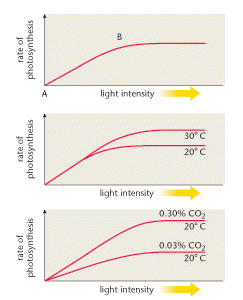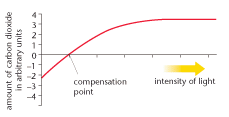Photosynthesis - Factors and Uses
Which factors affect photosynthesis?
If any process is to take place then correct components and conditions are required. In the case of photosynthesis these are:
- light
- carbon dioxide
- water
- suitable temperature.
Additionally, it is most important that the chloroplasts have been able to develop their photosynthetic pigments in the thylakoid membranes. Without an adequate supply of magnesium and iron a plant suffers from chlorosis due to chlorophyll not developing. The leaf colour becomes yellow-green and photosynthesis is reduced.
Limiting factors
If a component is in low supply then productivity is prevented from reaching maximum. In photosynthesis carbon dioxide is a key limiting factor. The usual atmospheric level of carbon dioxide is 0.03%. In perfect conditions of water availability, light and temperature this low carbon dioxide level holds back the photosynthetic potential.
Clearly light energy is vital to the process of photosynthesis. It is severely limiting at times of partial light conditions, e.g. dawn or dusk.
Water is vital as a photosynthetic component. It is used in many other processes and has a lesser effect as a limiting factor of photosynthesis. In times of water shortage a plant suffers from a range of problems associated with other processes before a major effect is observed on photosynthesis.
A range of enzymes are involved in photosynthesis, therefore the process has an
optimum temperature above and below which the rate reduces (so the
temperature of the plant’s environment can be limiting!).

Compensation point
Photosynthesis utilises carbon dioxide whereas respiration results in its excretion. At night time during darkness a plant respires and gives out carbon dioxide. Photosynthesis only commences when light becomes available at dawn, if all other conditions are met. At one point the amount of carbon dioxide released by respiration is totally re-used in photosynthesis. This is the compensation point.
Beyond this compensation point the plant may increasingly photosynthesise as conditions of temperature and light improve. The plant at this stage still respires producing carbon dioxide in its cells and all of this carbon dioxide is utilised. However, much more carbon dioxide is needed which diffuses in from the air.
In the evening when dusk arrives a point is reached when the rate of photosynthesis falls due to the decrease in light and the onset of darkness. The amount of carbon dioxide produced at one point is totally utilised in photosynthesis. Another compensation point has arrived!

How useful is Photosynthesis?
Without doubt it is a most important process because it supplies carbohydrates and gives off oxygen. There are many more benefits in that glucose is a ‘starter’ chemical for the synthesis of many other substances.
Cellulose, amino acids, and lipids are among the large number of chemicals which can be produced as a result of the initial process of photosynthesis. The work of the Royal Mint produces the money to run the economy, photosynthesis supplies the energy currency for the living world.
The table shows some examples of where and how some carbohydrates are used.
Carbohydrate Use
deoxyribose (monosaccharide) DNA ‘backbone’
glucose (monosaccharide) leaves, nectar, blood as energy supply
sucrose (disaccharide) sugar beet as energy store
lactose (disaccharide) milk as energy supply
cellulose (disaccharide) protective cover around all plant cells
starch (polysaccharide) energy store in plant cells
glycogen (polysaccharide) energy store in muscle and liver
